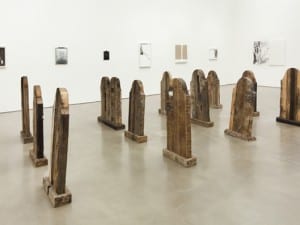Art, in the broadest sense of the term, has always encompassed a number of methods, traditions, and styles; public art is but one tradition that falls within the definition of this term and is the focus of a number of artists working within the UK.
Public art, that which is produced for the passerby and within the public sphere, functions as a starting point for aesthetic discourse and interaction. The production of narratives, specifically of the stories and myths that surround contemporary art practice, relies on the audience’s ability and capability to extract information from the works themselves: large-scale installations and projects necessarily involve the public through their situation within the public arena, yet it is the interaction of the audience with the work itself that creates the enduring myth or narrative.
The OpenEnded Group, comprised of Paul Kaiser, Shelley Eshkar, and Marc Downie, are but one collaboration of artists that utilize space, light, and architectural edifices to create art environments with which the public can (and do) interact. Recovered Light, their project this past January for the exterior of York Minster (as commissioned by Illuminating York), transformed the exterior of the Cathedral into a moving, 3-dimensional, interactive artwork through the use of light, technology, and movement. Their work, palpably influenced by John Cage and Merce Cunningham, animates and illuminates the mundane: York Minster, though famous in its own right, is a stable and static entity that was subject to an aesthetic remodelling and revision by OpenEnded Group. Unlike Cage and Cunningham, who were interested in the deconstruction of the narrative, OpenEnded Group is interested in the writing and re-writing of history: of, in the words of Kaiser, “[an] active interrogation of the past”, in order to actively consume history one must bring it alive, which is exactly what the group did this January. York Minster became not only the architectural backdrop, but the driving inspiration and force behind the artworks genesis.
There is an obvious comparison to be made between the work of OpenEnded Group and Angus Farquhar, and a much more obvious citation of Christo as an influence (perhaps more so in Farquhar’s oeuvre). Farquhar articulates the character of the landscape through 3-dimensional interactions, specifically with light, in works such as The Path (2000) and The Storr: Unfolding Landscape (2005). He requires a higher degree of physical interaction and involvement from his audience. The Path, was a four mile hike through the Scottish highlands, it was physically demanding but it was the very physicality of the event that enabled the audience to not only create a strong and resonant narrative, but to simultaneously own the work. The interaction of audience and artwork is the driving impetus behind contemporary public art projects: to allow the public to feel a sense of attachment to the work necessarily produces a sense of pride, community, and consequently instigates debate. Richard Serra’s Tilted Arc (1981) is perhaps the seminal example of a public art commission gone awry: the 120-foot long sculpture was at the centre of a maelstrom of debate from the moment of its unveiling to its subsequent dismantling in 1989 and continues to be so.
Farquhar and the OpenEnded Group create less physically invasive works: rather than integrating a monstrous steel structure into an urban environment (as did Serra), they use light, technology, sound, and movement to alter the environment in a more ephemeral manner. Kaiser argues that it is difficult to develop a concrete, fixed idea of how public art projects will turn out as public projects are dependent on the frame of the site and the way in which the experience shifts according to the day and person. Farquhar’s work parallels Kaiser’s argument as his is created in response to the environment and focuses on the way in which land shapes, and is shaped by, its inhabitants. Farquhar cites the twentieth century filmmakers Sergei Eisenstein, Andrei Tarkovsky, and Werner Herzog as influences: the cinematic quality and scale of his work is a direct reference and homage to their films (specifically Tarkovsky’s Stalker (1979) as influential on The Storr). It is this idea of the cinema that provides the clearest articulation of the direction that contemporary public art installations will be heading in the near future: the use of technology within the public realm affords new possibilities to artists, provided they have the skills and foresight to take advantage as have Kaiser, Eshkar, Downie, and Farquhar.
For further information: OpenEnded Group’s website provides a history of the group and their past projects at www.openendedgroup.com; Angus Farquhar, in conjunction with the environmental arts charity NVA, can be viewed at www.nva.org.uk.
Niamh Coghlan





